北师大版(2019)必修 第三册Unit 7 Art Lesson 1 Masterpieces名师教学设计
文档属性
| 名称 | 北师大版(2019)必修 第三册Unit 7 Art Lesson 1 Masterpieces名师教学设计 |
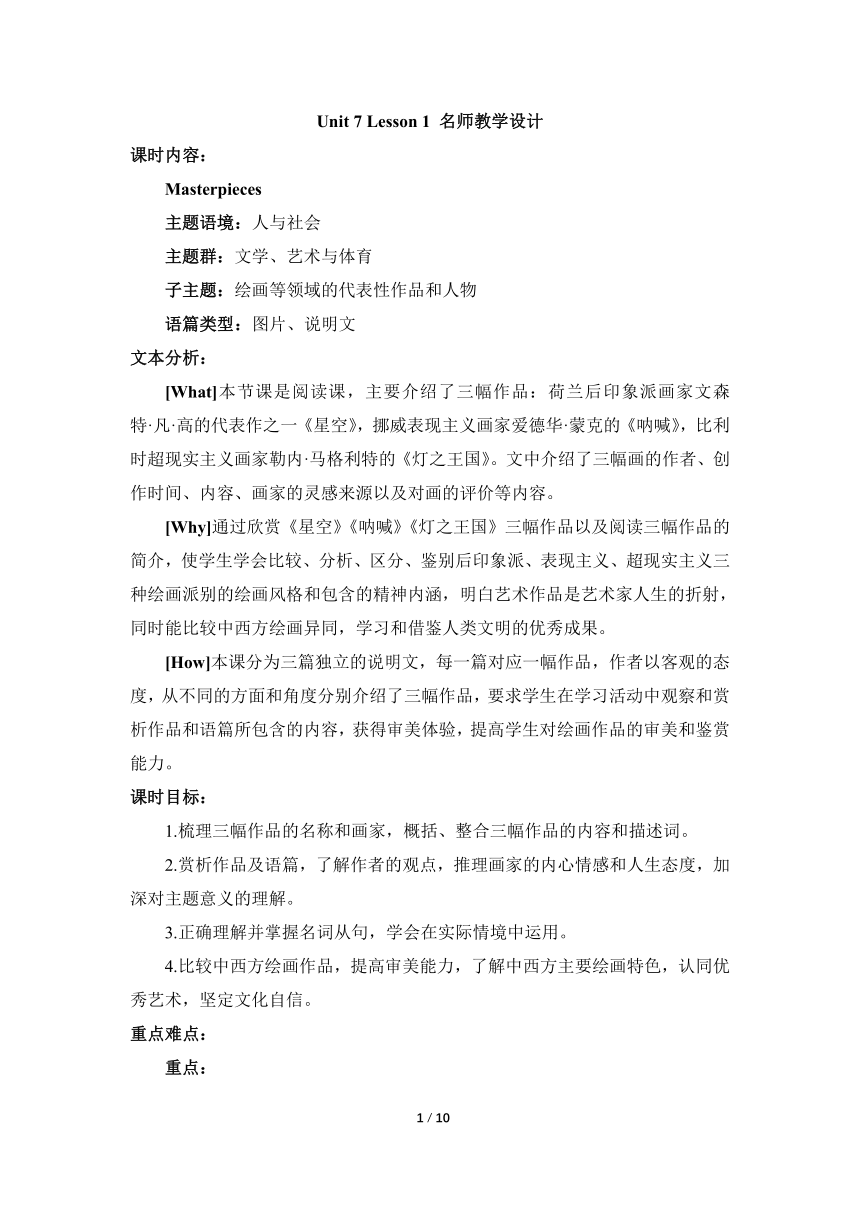
|
|
| 格式 | docx | ||
| 文件大小 | 247.1KB | ||
| 资源类型 | 教案 | ||
| 版本资源 | 北师大版(2019) | ||
| 科目 | 英语 | ||
| 更新时间 | 2023-03-07 20:58:28 | ||
图片预览

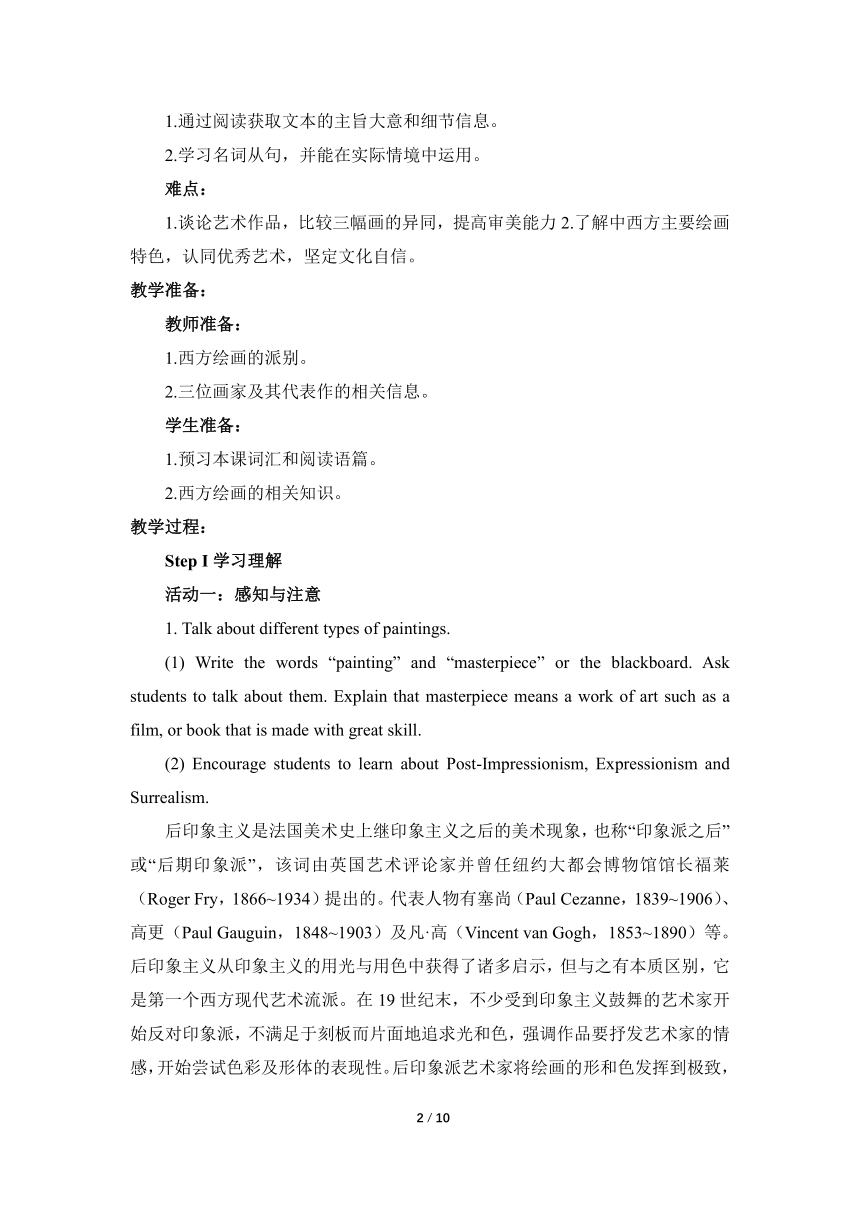
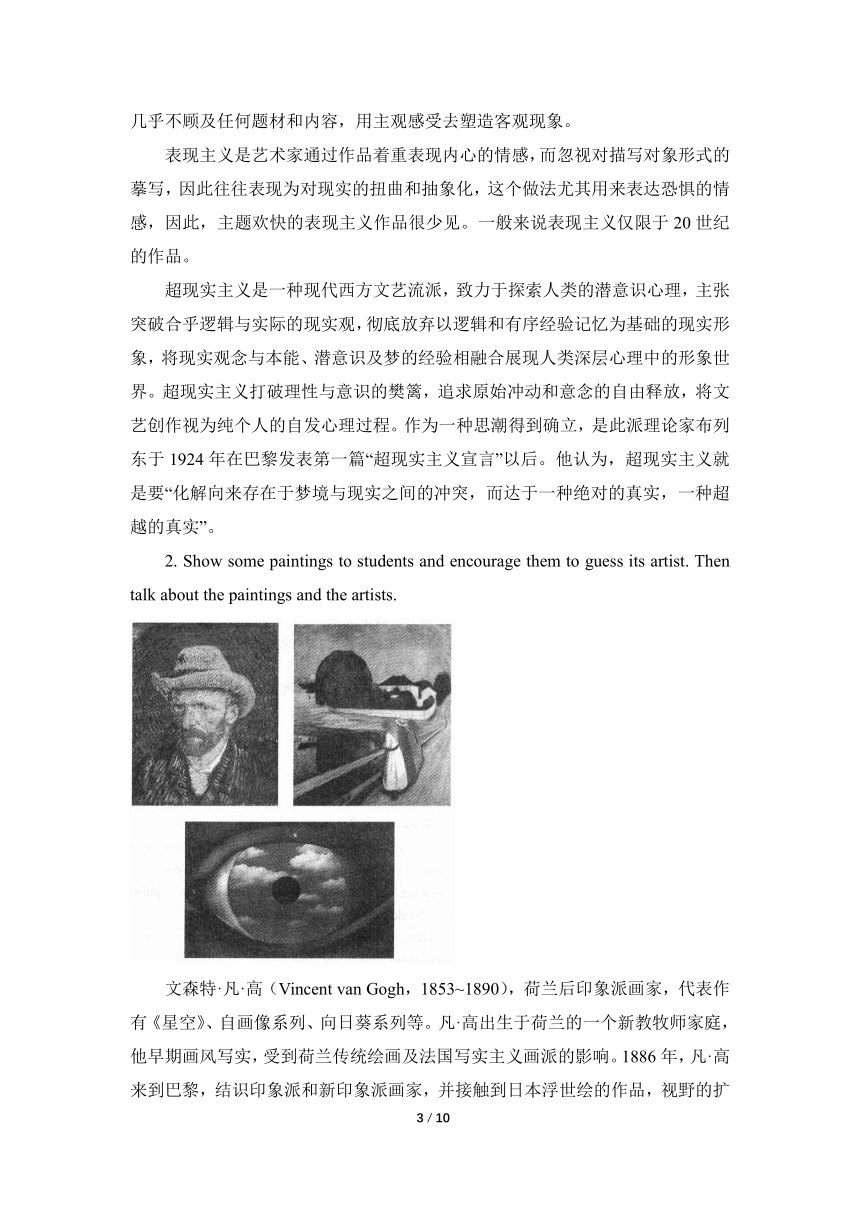
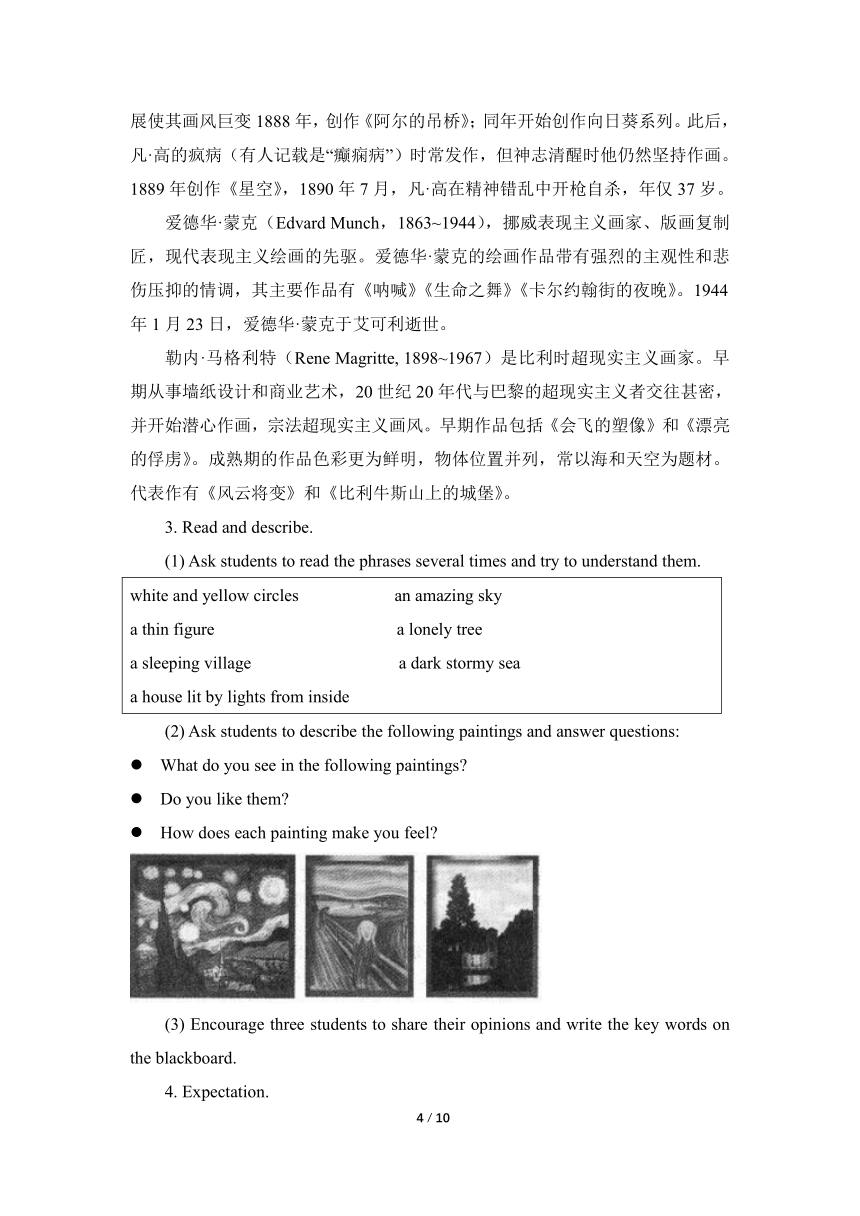
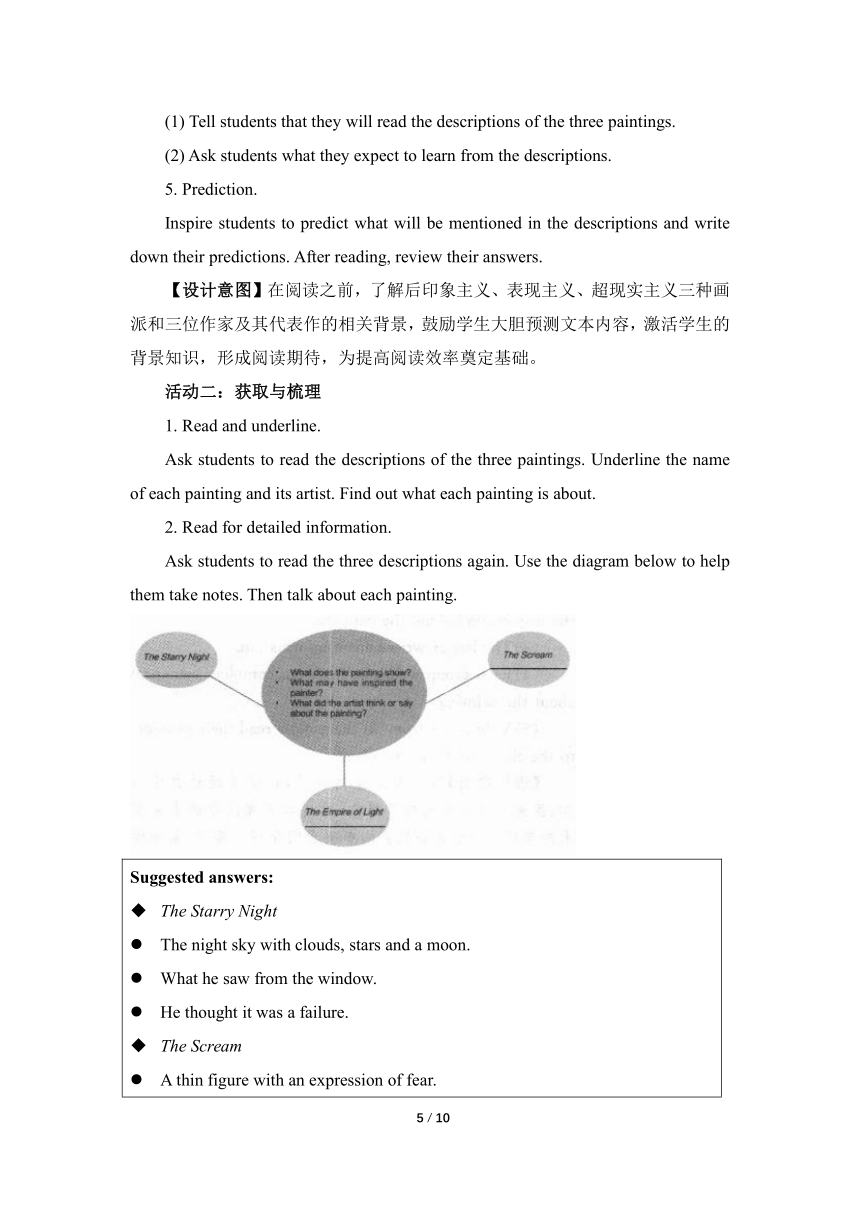
文档简介
Unit 7 Lesson 1 名师教学设计
课时内容:
Masterpieces
主题语境:人与社会
主题群:文学、艺术与体育
子主题:绘画等领域的代表性作品和人物
语篇类型:图片、说明文
文本分析:
[What]本节课是阅读课,主要介绍了三幅作品:荷兰后印象派画家文森特·凡·高的代表作之一《星空》,挪威表现主义画家爱德华·蒙克的《呐喊》,比利时超现实主义画家勒内·马格利特的《灯之王国》。文中介绍了三幅画的作者、创作时间、内容、画家的灵感来源以及对画的评价等内容。
[Why]通过欣赏《星空》《呐喊》《灯之王国》三幅作品以及阅读三幅作品的简介,使学生学会比较、分析、区分、鉴别后印象派、表现主义、超现实主义三种绘画派别的绘画风格和包含的精神内涵,明白艺术作品是艺术家人生的折射,同时能比较中西方绘画异同,学习和借鉴人类文明的优秀成果。
[How]本课分为三篇独立的说明文,每一篇对应一幅作品,作者以客观的态度,从不同的方面和角度分别介绍了三幅作品,要求学生在学习活动中观察和赏析作品和语篇所包含的内容,获得审美体验,提高学生对绘画作品的审美和鉴赏能力。
课时目标:
1.梳理三幅作品的名称和画家,概括、整合三幅作品的内容和描述词。
2.赏析作品及语篇,了解作者的观点,推理画家的内心情感和人生态度,加深对主题意义的理解。
3.正确理解并掌握名词从句,学会在实际情境中运用。
4.比较中西方绘画作品,提高审美能力,了解中西方主要绘画特色,认同优秀艺术,坚定文化自信。
重点难点:
重点:
1.通过阅读获取文本的主旨大意和细节信息。
2.学习名词从句,并能在实际情境中运用。
难点:
1.谈论艺术作品,比较三幅画的异同,提高审美能力2.了解中西方主要绘画特色,认同优秀艺术,坚定文化自信。
教学准备:
教师准备:
1.西方绘画的派别。
2.三位画家及其代表作的相关信息。
学生准备:
1.预习本课词汇和阅读语篇。
2.西方绘画的相关知识。
教学过程:
Step I学习理解
活动一:感知与注意
1. Talk about different types of paintings.
(1) Write the words “painting” and “masterpiece” or the blackboard. Ask students to talk about them. Explain that masterpiece means a work of art such as a film, or book that is made with great skill.
(2) Encourage students to learn about Post-Impressionism, Expressionism and Surrealism.
后印象主义是法国美术史上继印象主义之后的美术现象,也称“印象派之后”或“后期印象派”,该词由英国艺术评论家并曾任纽约大都会博物馆馆长福莱(Roger Fry,1866~1934)提出的。代表人物有塞尚(Paul Cezanne,1839~1906)、高更(Paul Gauguin,1848~1903)及凡·高(Vincent van Gogh,1853~1890)等。后印象主义从印象主义的用光与用色中获得了诸多启示,但与之有本质区别,它是第一个西方现代艺术流派。在19世纪末,不少受到印象主义鼓舞的艺术家开始反对印象派,不满足于刻板而片面地追求光和色,强调作品要抒发艺术家的情感,开始尝试色彩及形体的表现性。后印象派艺术家将绘画的形和色发挥到极致,几乎不顾及任何题材和内容,用主观感受去塑造客观现象。
表现主义是艺术家通过作品着重表现内心的情感,而忽视对描写对象形式的摹写,因此往往表现为对现实的扭曲和抽象化,这个做法尤其用来表达恐惧的情感,因此,主题欢快的表现主义作品很少见。一般来说表现主义仅限于20世纪的作品。
超现实主义是一种现代西方文艺流派,致力于探索人类的潜意识心理,主张突破合乎逻辑与实际的现实观,彻底放弃以逻辑和有序经验记忆为基础的现实形象,将现实观念与本能、潜意识及梦的经验相融合展现人类深层心理中的形象世界。超现实主义打破理性与意识的樊篱,追求原始冲动和意念的自由释放,将文艺创作视为纯个人的自发心理过程。作为一种思潮得到确立,是此派理论家布列东于1924年在巴黎发表第一篇“超现实主义宣言”以后。他认为,超现实主义就是要“化解向来存在于梦境与现实之间的冲突,而达于一种绝对的真实,一种超越的真实”。
2. Show some paintings to students and encourage them to guess its artist. Then talk about the paintings and the artists.
文森特·凡·高(Vincent van Gogh,1853~1890),荷兰后印象派画家,代表作有《星空》、自画像系列、向日葵系列等。凡·高出生于荷兰的一个新教牧师家庭,他早期画风写实,受到荷兰传统绘画及法国写实主义画派的影响。1886年,凡·高来到巴黎,结识印象派和新印象派画家,并接触到日本浮世绘的作品,视野的扩展使其画风巨变1888年,创作《阿尔的吊桥》;同年开始创作向日葵系列。此后,凡·高的疯病(有人记载是“癫痫病”)时常发作,但神志清醒时他仍然坚持作画。1889年创作《星空》,1890年7月,凡·高在精神错乱中开枪自杀,年仅37岁。
爱德华·蒙克(Edvard Munch,1863~1944),挪威表现主义画家、版画复制匠,现代表现主义绘画的先驱。爱德华·蒙克的绘画作品带有强烈的主观性和悲伤压抑的情调,其主要作品有《呐喊》《生命之舞》《卡尔约翰街的夜晚》。1944年1月23日,爱德华·蒙克于艾可利逝世。
勒内·马格利特(Rene Magritte, 1898~1967)是比利时超现实主义画家。早期从事墙纸设计和商业艺术,20世纪20年代与巴黎的超现实主义者交往甚密,并开始潜心作画,宗法超现实主义画风。早期作品包括《会飞的塑像》和《漂亮的俘虏》。成熟期的作品色彩更为鲜明,物体位置并列,常以海和天空为题材。代表作有《风云将变》和《比利牛斯山上的城堡》。
3. Read and describe.
(1) Ask students to read the phrases several times and try to understand them.
white and yellow circles an amazing sky a thin figure a lonely tree a sleeping village a dark stormy sea a house lit by lights from inside
(2) Ask students to describe the following paintings and answer questions:
What do you see in the following paintings
Do you like them
How does each painting make you feel
(3) Encourage three students to share their opinions and write the key words on the blackboard.
4. Expectation.
(1) Tell students that they will read the descriptions of the three paintings.
(2) Ask students what they expect to learn from the descriptions.
5. Prediction.
Inspire students to predict what will be mentioned in the descriptions and write down their predictions. After reading, review their answers.
【设计意图】在阅读之前,了解后印象主义、表现主义、超现实主义三种画派和三位作家及其代表作的相关背景,鼓励学生大胆预测文本内容,激活学生的背景知识,形成阅读期待,为提高阅读效率奠定基础。
活动二:获取与梳理
1. Read and underline.
Ask students to read the descriptions of the three paintings. Underline the name of each painting and its artist. Find out what each painting is about.
2. Read for detailed information.
Ask students to read the three descriptions again. Use the diagram below to help them take notes. Then talk about each painting.
Suggested answers: The Starry Night The night sky with clouds, stars and a moon. What he saw from the window. He thought it was a failure. The Scream A thin figure with an expression of fear. His experience of walking with friends. Not mentioned in the text. The Empire of Light A beautiful house lit by lights from inside surrounded by the darkness of night. His thoughts and ideas. The change bet ween day and night in the paintings was surprising.
3. Read and fill.
Ask students to sort the expressions into the correct columns. Use them to practise introducing the paintings.
The Starry Night The Scream The Empire of Light
With an expression of fear let out a powerful scream Circles of white and yellow racing across the sky a burning orange-red sky surrounded by the darkness of night the night sky with clouds, stars and a moon a beautiful house lit by lights from inside full of brightness and soft white clouds looks directly at the viewer a sleeping village and a dark, lonely tree
Suggested answers: The Starry night ③,⑥,⑩ The scream ①,②,④,⑨ The Empire of Light ⑤,⑦,⑧
【设计意图】在阅读过程中,设置了回答问题、填表等任务,鼓励学生从语篇中获得新知,建立信息间的关联,成新的认知结构并理解语篇所表达的意义。
4. Focus on language: Noun clauses.
【备注】语法知识点讲解详见第二教案“重点语法精讲”。
活动三:概括与整合
Ask students to share their feelings by answering the following question:
Have you found anything you feel excited,interested, attractive about the three paintings
【设计意图】以分享阅读感受为任务,让学生独立思考,使学生学会揣摩作品所传递的思想情感。
Step Ⅱ 应用实践
活动四:描述与阐释
1. Find the common features.
Ask students to look at the three paintings and read the first paragraph of each description. Do they have anything in common If so, underline the words and phrases in the descriptions that show their common features. Let students explain their opinions.
Example: dark/darkness…
Suggested answers: The words and phrases in the descriptions; the massive circles of white and yellow racing across the sky a burning orange-red sky; a daytime sky full of brightness and soft white clouds a dark, lonely tree; a dark, stormy sea; the darkness of night Each painting is focused on the artist’s interpretation of nature, especially the aspects of the sky. All three paintings paint the sky with bright colours and the darkness in each one manifests a typical feature.
2. Write a summary.
(1) Ask students to work in groups of three, and each student writes a summary for one painting.
(2) Share in the group.
活动五:分析与判断
1. Ask students to learn the following expressions:
artistic beauty, originality, emotional, atmosphere, colour scheme, dramatic, highlight, the painting makes me feel uneasy/inspired, dark and troubling, failure, powerful
2. Instruct students to work independently and write few sentences on each painting,expressing their opinion according to the following questions.
What’s your opinion of the three paintings after reading the descriptions
Do you like or dislike them more Give your reasons.
3. Encourage students to voice their opinions in class.
【设计意图】在学习理解类活动的基础上,教师指导学生围绕主题和所形成的新的知识结构展开不同的活动,学生描述三幅作品表达自己的观点并说明理由等,复习旧知,巩固新的知识结构,逐步实现对语言知识和文化知识的内化,促进语言运用的自动化,助力学生将知识转化为能力。
Step Ⅲ 迁移创新
活动六:推理与论证
Ask students to discuss in pairs and answer the two questions:
What is the purpose of the three descriptions
What do you think of the three artists and the lives
Suggested answers: To introduce the three paintings to the readers. (略)
【设计意图】教师引导学生针对语篇对作者的写作目的进行推理论证,探讨其与主题意义的关联,挖掘作品与画家现实生活的关联,使学生明白“艺术源于生活,高于生画家把深层次的动机、情感、价值观、愿望等投射在作品上”,加深对主题意义的理解。
活动七:想象与创造
1. Ask students to suppose they are volunteers at an art exhibition. Introduce one of the three paintings to the visitors.
(1) Divide the class into some groups. Each group chooses one painting,selects one student to be the leader and writes down notes for the group.
(2) Each student in the group describes the painting and provides the background to the painting,the artist and the inspiration behind the painting.
(3) The leader writes down information.
(4) Each group writes at least ten complete sentences about the painting.
(5) Volunteers from all the groups read their passages to the class and then role-play.
【设计意图】设置开放型的任务,让学生通过自主合作、探究的学习方式展开想象,运用本节课所学的有关艺术的单词和词组向展览会的参观者们介绍一幅画,创造性地解决现实生活中可能会遇到的问题,做到举一反三,学以致用,实现深度学习,促进能力向素养的转化。
2. Show a Chinese painting to students and ask them to discuss the differences between Chinese and Western paintings.
【设计意图】在欣赏西方三幅作品之后,呈现一幅中国画,引导学生学习中外优秀文化的异同,有助于学生在对不同艺术进行比较鉴赏、批判和反思的过程中,拓宽国际视野,理解和包容不同艺术形式,增强对中华优秀艺术的认识,有助于促进英语学科核心素养的形成和发展。
板书设计:
Unit 7 Art Period Ⅱ Lesson 1 I.学习理解 活动一:感知与注意 1. Talk about different types of paintings. 2. Talk about some paintings and its artist. 3. Read and describe. 4. Expectation. 5. Prediction. 活动二:获取与梳理 1. Read and underline. 2. Read for detailed information. 3. Read and fill. 4. Focus on language: Noun clauses. 活动三:概括与整合 Ⅱ.应用实践 活动四:描述与阐释 1. Find the common features. 2. Write a summary. 活动五:分析与判断 Ⅲ.迁移创新 活动六:推理与论证 活动七:想象与创造
2 / 2
课时内容:
Masterpieces
主题语境:人与社会
主题群:文学、艺术与体育
子主题:绘画等领域的代表性作品和人物
语篇类型:图片、说明文
文本分析:
[What]本节课是阅读课,主要介绍了三幅作品:荷兰后印象派画家文森特·凡·高的代表作之一《星空》,挪威表现主义画家爱德华·蒙克的《呐喊》,比利时超现实主义画家勒内·马格利特的《灯之王国》。文中介绍了三幅画的作者、创作时间、内容、画家的灵感来源以及对画的评价等内容。
[Why]通过欣赏《星空》《呐喊》《灯之王国》三幅作品以及阅读三幅作品的简介,使学生学会比较、分析、区分、鉴别后印象派、表现主义、超现实主义三种绘画派别的绘画风格和包含的精神内涵,明白艺术作品是艺术家人生的折射,同时能比较中西方绘画异同,学习和借鉴人类文明的优秀成果。
[How]本课分为三篇独立的说明文,每一篇对应一幅作品,作者以客观的态度,从不同的方面和角度分别介绍了三幅作品,要求学生在学习活动中观察和赏析作品和语篇所包含的内容,获得审美体验,提高学生对绘画作品的审美和鉴赏能力。
课时目标:
1.梳理三幅作品的名称和画家,概括、整合三幅作品的内容和描述词。
2.赏析作品及语篇,了解作者的观点,推理画家的内心情感和人生态度,加深对主题意义的理解。
3.正确理解并掌握名词从句,学会在实际情境中运用。
4.比较中西方绘画作品,提高审美能力,了解中西方主要绘画特色,认同优秀艺术,坚定文化自信。
重点难点:
重点:
1.通过阅读获取文本的主旨大意和细节信息。
2.学习名词从句,并能在实际情境中运用。
难点:
1.谈论艺术作品,比较三幅画的异同,提高审美能力2.了解中西方主要绘画特色,认同优秀艺术,坚定文化自信。
教学准备:
教师准备:
1.西方绘画的派别。
2.三位画家及其代表作的相关信息。
学生准备:
1.预习本课词汇和阅读语篇。
2.西方绘画的相关知识。
教学过程:
Step I学习理解
活动一:感知与注意
1. Talk about different types of paintings.
(1) Write the words “painting” and “masterpiece” or the blackboard. Ask students to talk about them. Explain that masterpiece means a work of art such as a film, or book that is made with great skill.
(2) Encourage students to learn about Post-Impressionism, Expressionism and Surrealism.
后印象主义是法国美术史上继印象主义之后的美术现象,也称“印象派之后”或“后期印象派”,该词由英国艺术评论家并曾任纽约大都会博物馆馆长福莱(Roger Fry,1866~1934)提出的。代表人物有塞尚(Paul Cezanne,1839~1906)、高更(Paul Gauguin,1848~1903)及凡·高(Vincent van Gogh,1853~1890)等。后印象主义从印象主义的用光与用色中获得了诸多启示,但与之有本质区别,它是第一个西方现代艺术流派。在19世纪末,不少受到印象主义鼓舞的艺术家开始反对印象派,不满足于刻板而片面地追求光和色,强调作品要抒发艺术家的情感,开始尝试色彩及形体的表现性。后印象派艺术家将绘画的形和色发挥到极致,几乎不顾及任何题材和内容,用主观感受去塑造客观现象。
表现主义是艺术家通过作品着重表现内心的情感,而忽视对描写对象形式的摹写,因此往往表现为对现实的扭曲和抽象化,这个做法尤其用来表达恐惧的情感,因此,主题欢快的表现主义作品很少见。一般来说表现主义仅限于20世纪的作品。
超现实主义是一种现代西方文艺流派,致力于探索人类的潜意识心理,主张突破合乎逻辑与实际的现实观,彻底放弃以逻辑和有序经验记忆为基础的现实形象,将现实观念与本能、潜意识及梦的经验相融合展现人类深层心理中的形象世界。超现实主义打破理性与意识的樊篱,追求原始冲动和意念的自由释放,将文艺创作视为纯个人的自发心理过程。作为一种思潮得到确立,是此派理论家布列东于1924年在巴黎发表第一篇“超现实主义宣言”以后。他认为,超现实主义就是要“化解向来存在于梦境与现实之间的冲突,而达于一种绝对的真实,一种超越的真实”。
2. Show some paintings to students and encourage them to guess its artist. Then talk about the paintings and the artists.
文森特·凡·高(Vincent van Gogh,1853~1890),荷兰后印象派画家,代表作有《星空》、自画像系列、向日葵系列等。凡·高出生于荷兰的一个新教牧师家庭,他早期画风写实,受到荷兰传统绘画及法国写实主义画派的影响。1886年,凡·高来到巴黎,结识印象派和新印象派画家,并接触到日本浮世绘的作品,视野的扩展使其画风巨变1888年,创作《阿尔的吊桥》;同年开始创作向日葵系列。此后,凡·高的疯病(有人记载是“癫痫病”)时常发作,但神志清醒时他仍然坚持作画。1889年创作《星空》,1890年7月,凡·高在精神错乱中开枪自杀,年仅37岁。
爱德华·蒙克(Edvard Munch,1863~1944),挪威表现主义画家、版画复制匠,现代表现主义绘画的先驱。爱德华·蒙克的绘画作品带有强烈的主观性和悲伤压抑的情调,其主要作品有《呐喊》《生命之舞》《卡尔约翰街的夜晚》。1944年1月23日,爱德华·蒙克于艾可利逝世。
勒内·马格利特(Rene Magritte, 1898~1967)是比利时超现实主义画家。早期从事墙纸设计和商业艺术,20世纪20年代与巴黎的超现实主义者交往甚密,并开始潜心作画,宗法超现实主义画风。早期作品包括《会飞的塑像》和《漂亮的俘虏》。成熟期的作品色彩更为鲜明,物体位置并列,常以海和天空为题材。代表作有《风云将变》和《比利牛斯山上的城堡》。
3. Read and describe.
(1) Ask students to read the phrases several times and try to understand them.
white and yellow circles an amazing sky a thin figure a lonely tree a sleeping village a dark stormy sea a house lit by lights from inside
(2) Ask students to describe the following paintings and answer questions:
What do you see in the following paintings
Do you like them
How does each painting make you feel
(3) Encourage three students to share their opinions and write the key words on the blackboard.
4. Expectation.
(1) Tell students that they will read the descriptions of the three paintings.
(2) Ask students what they expect to learn from the descriptions.
5. Prediction.
Inspire students to predict what will be mentioned in the descriptions and write down their predictions. After reading, review their answers.
【设计意图】在阅读之前,了解后印象主义、表现主义、超现实主义三种画派和三位作家及其代表作的相关背景,鼓励学生大胆预测文本内容,激活学生的背景知识,形成阅读期待,为提高阅读效率奠定基础。
活动二:获取与梳理
1. Read and underline.
Ask students to read the descriptions of the three paintings. Underline the name of each painting and its artist. Find out what each painting is about.
2. Read for detailed information.
Ask students to read the three descriptions again. Use the diagram below to help them take notes. Then talk about each painting.
Suggested answers: The Starry Night The night sky with clouds, stars and a moon. What he saw from the window. He thought it was a failure. The Scream A thin figure with an expression of fear. His experience of walking with friends. Not mentioned in the text. The Empire of Light A beautiful house lit by lights from inside surrounded by the darkness of night. His thoughts and ideas. The change bet ween day and night in the paintings was surprising.
3. Read and fill.
Ask students to sort the expressions into the correct columns. Use them to practise introducing the paintings.
The Starry Night The Scream The Empire of Light
With an expression of fear let out a powerful scream Circles of white and yellow racing across the sky a burning orange-red sky surrounded by the darkness of night the night sky with clouds, stars and a moon a beautiful house lit by lights from inside full of brightness and soft white clouds looks directly at the viewer a sleeping village and a dark, lonely tree
Suggested answers: The Starry night ③,⑥,⑩ The scream ①,②,④,⑨ The Empire of Light ⑤,⑦,⑧
【设计意图】在阅读过程中,设置了回答问题、填表等任务,鼓励学生从语篇中获得新知,建立信息间的关联,成新的认知结构并理解语篇所表达的意义。
4. Focus on language: Noun clauses.
【备注】语法知识点讲解详见第二教案“重点语法精讲”。
活动三:概括与整合
Ask students to share their feelings by answering the following question:
Have you found anything you feel excited,interested, attractive about the three paintings
【设计意图】以分享阅读感受为任务,让学生独立思考,使学生学会揣摩作品所传递的思想情感。
Step Ⅱ 应用实践
活动四:描述与阐释
1. Find the common features.
Ask students to look at the three paintings and read the first paragraph of each description. Do they have anything in common If so, underline the words and phrases in the descriptions that show their common features. Let students explain their opinions.
Example: dark/darkness…
Suggested answers: The words and phrases in the descriptions; the massive circles of white and yellow racing across the sky a burning orange-red sky; a daytime sky full of brightness and soft white clouds a dark, lonely tree; a dark, stormy sea; the darkness of night Each painting is focused on the artist’s interpretation of nature, especially the aspects of the sky. All three paintings paint the sky with bright colours and the darkness in each one manifests a typical feature.
2. Write a summary.
(1) Ask students to work in groups of three, and each student writes a summary for one painting.
(2) Share in the group.
活动五:分析与判断
1. Ask students to learn the following expressions:
artistic beauty, originality, emotional, atmosphere, colour scheme, dramatic, highlight, the painting makes me feel uneasy/inspired, dark and troubling, failure, powerful
2. Instruct students to work independently and write few sentences on each painting,expressing their opinion according to the following questions.
What’s your opinion of the three paintings after reading the descriptions
Do you like or dislike them more Give your reasons.
3. Encourage students to voice their opinions in class.
【设计意图】在学习理解类活动的基础上,教师指导学生围绕主题和所形成的新的知识结构展开不同的活动,学生描述三幅作品表达自己的观点并说明理由等,复习旧知,巩固新的知识结构,逐步实现对语言知识和文化知识的内化,促进语言运用的自动化,助力学生将知识转化为能力。
Step Ⅲ 迁移创新
活动六:推理与论证
Ask students to discuss in pairs and answer the two questions:
What is the purpose of the three descriptions
What do you think of the three artists and the lives
Suggested answers: To introduce the three paintings to the readers. (略)
【设计意图】教师引导学生针对语篇对作者的写作目的进行推理论证,探讨其与主题意义的关联,挖掘作品与画家现实生活的关联,使学生明白“艺术源于生活,高于生画家把深层次的动机、情感、价值观、愿望等投射在作品上”,加深对主题意义的理解。
活动七:想象与创造
1. Ask students to suppose they are volunteers at an art exhibition. Introduce one of the three paintings to the visitors.
(1) Divide the class into some groups. Each group chooses one painting,selects one student to be the leader and writes down notes for the group.
(2) Each student in the group describes the painting and provides the background to the painting,the artist and the inspiration behind the painting.
(3) The leader writes down information.
(4) Each group writes at least ten complete sentences about the painting.
(5) Volunteers from all the groups read their passages to the class and then role-play.
【设计意图】设置开放型的任务,让学生通过自主合作、探究的学习方式展开想象,运用本节课所学的有关艺术的单词和词组向展览会的参观者们介绍一幅画,创造性地解决现实生活中可能会遇到的问题,做到举一反三,学以致用,实现深度学习,促进能力向素养的转化。
2. Show a Chinese painting to students and ask them to discuss the differences between Chinese and Western paintings.
【设计意图】在欣赏西方三幅作品之后,呈现一幅中国画,引导学生学习中外优秀文化的异同,有助于学生在对不同艺术进行比较鉴赏、批判和反思的过程中,拓宽国际视野,理解和包容不同艺术形式,增强对中华优秀艺术的认识,有助于促进英语学科核心素养的形成和发展。
板书设计:
Unit 7 Art Period Ⅱ Lesson 1 I.学习理解 活动一:感知与注意 1. Talk about different types of paintings. 2. Talk about some paintings and its artist. 3. Read and describe. 4. Expectation. 5. Prediction. 活动二:获取与梳理 1. Read and underline. 2. Read for detailed information. 3. Read and fill. 4. Focus on language: Noun clauses. 活动三:概括与整合 Ⅱ.应用实践 活动四:描述与阐释 1. Find the common features. 2. Write a summary. 活动五:分析与判断 Ⅲ.迁移创新 活动六:推理与论证 活动七:想象与创造
2 / 2
同课章节目录
- Unit 7 Art
- Lesson 1 Masterpieces
- Lesson 2 Beijing Opera
- Lesson 3 A Musical Genius
- Unit 8 Green living
- Lesson 1 Roots and Shoots
- Lesson 2 Greening the Desert
- Lesson 3 "White Bikes" on the Road
- Unit 9 Learning
- Lesson 1 Active Learning
- Lesson 2 Language Learning Tips
- Lesson 3 The Secrets of Your Memory
